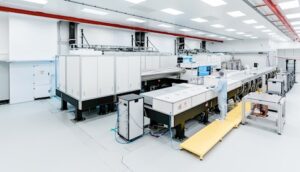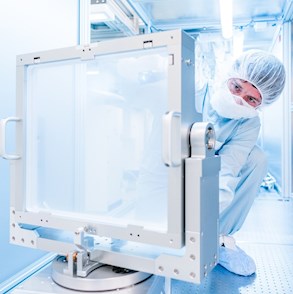ELI’s L4 ATON Laser Achieves 5 Petawatt
The L4 ATON Kilojoule laser at the Extreme Light Infrastructure (ELI) – ELI Beamlines Facility achieved a peak power exceeding 5 petawatts (PW = 10¹⁵ W, or one million billion watts). This confirmed that the L4 can be operated safely and reliably at this energy level which is key for scaling up to higher power and preparing for scientific experiments.
During a test campaign in September, the flagship L4 ATON system demonstrated a laser performance of 786 J energy compressed to 154 fs, corresponding to a peak power of 5.1 PW. This currently represents the highest pulse energy achieved worldwide at the multi-petawatt power level.
High-Power Laser Technology Development
The L4 ATON laser system was developed by a consortium of international partners made up of National Energetics (USA) and EKSPLA (Lithuania) and the ELI Beamlines Facility team. L4 ATON combines optical parametric chirped pulse amplification (OPCPA) with a kilojoule-class, liquid-cooled glass amplifier, allowing operation at a repetition rate of one shot per minute, an order of magnitude higher than other lasers of comparable energy.
Installed in the autumn of 2018, a series of upgrades led by ELI Beamlines’ laser and engineering teams, introduced innovations in amplifier cooling, laser diagnostics, control systems, and adaptive optics, significantly improving beam quality, stability, and reliability which have gradually built unique in-house expertise in the design, alignment, and operation of high-energy, high-repetition-rate laser systems.
The imposing 18 metres long vacuum compressor system was constructed for the final femtosecond pulse compression. Working in cooperation with Lawrence Livermore National Laboratory (USA), new multilayer dielectric (MLD) diffraction gratings were developed which are a key innovation enabling operation at extremely high energy densities on optical components.
Advancing high-power laser science and access for the user community
Since 2021, the L4 ATON laser has been serving scientific experiments within the Plasma Physics Platform (P3). A commissioning campaign in December 2025 will integrate the system with new experimental setups, paving the way for external user experiments beginning in 2027 under the ELI User Programme.
With its high stability and ability to repeat experiments at one-minute intervals, L4 ATON opens new possibilities for studies in laser-driven particle acceleration, extreme-state physics, and strong-field quantum electrodynamics (QED), as well as for further progress in laser-driven fusion research.
The ELI team is analysing performance data to increase power toward 10 PW in 2026. This next step will expand the facility’s experimental reach even further, solidifying ELI’s position among the world’s leading research facilities for high-intensity laser science.
Source: https://www.eli-beams.eu/


